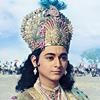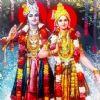Found this interesting bit from "Ancient Indian Historical Tradition" by F. E. Pargiter.
There is a story that connects the Yadavas and Rama of Ayodhya.
It is prefaced by a spurious genealogy noticed in chapter X, but the
material passage ^ appears to contain genuine tradition because it
is corroborated elsewhere and explains the name of the country
Surasena. It gives these descendants of the great Yadava king
Madhu,^ namely, Madhava, his son Satvata, his son Bhima and his
son Andhaka, and these tally with the genealogical version Satvant,
Satvata, and Andhaka. It says BhIma Satvata was contemporary
with Rama ; Ramans brother Satrughna killed the Yadava Lavana,
cut down the forest Madhuvana and built the city Mathura there
;
when Rama and his brothers died, Bhima recovered the city ; and
Andhaka reigned there contemporary with Ramans son Kusa at
Ayodhya. The genealogies say that Satrughna killed the Madhava
Lavana, went to Madhuvana, built Mathura and reigned there with
his two sons Subahu and Surasena.^ Here then we have Satvant
and Bhima contemporary with Rama, and Andhaka with Kusa.
Another version * amplifies what the genealogies say with some
mistaken embellishments, as that Lavana was son, instead of
descendant, of Madhu, and that Madhuvana was in Ayodhya
territory, whereas South Pancala separated them. The Ramayana gives a third version, similar but largely amplified and brahmanized
with various mistakes.^ Mathura was the capital o the Surasena
country ; the country appears to have obtained its name from
Satrughna's son Surasena,^ and Andhaka's descendants reigned there
down to Ugrasena and Kamsa ; so the second version says.[/quote]
This suggests that the Andhaka tribe ruled over Mathura for a very long time. Couldn't find any information on the curse however.


















comment:
p_commentcount